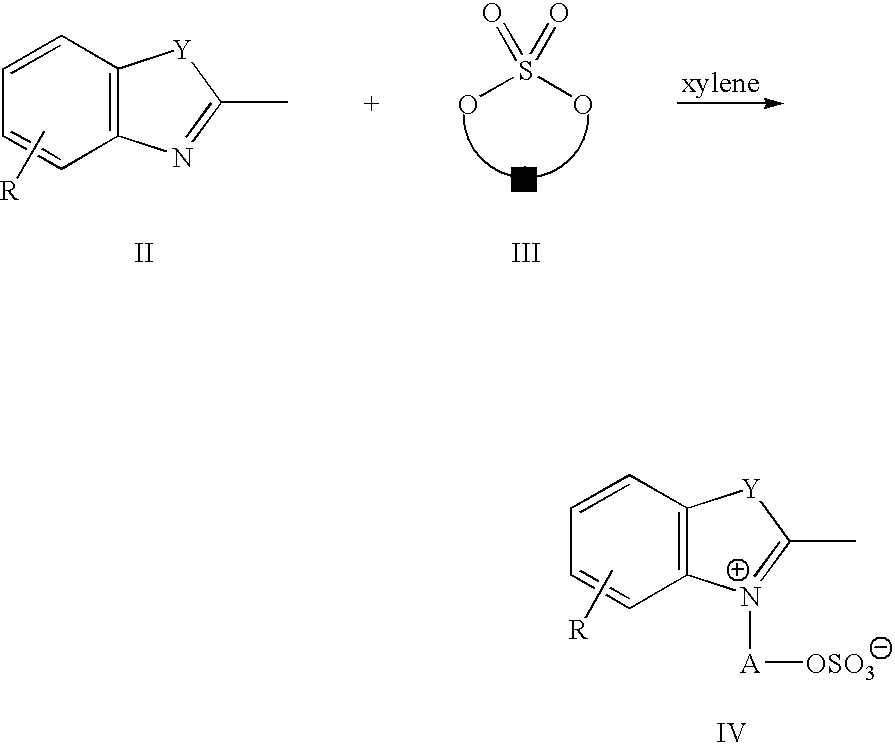Infrared absorbing compounds and their use in imageable elements
a technology of infrared absorption and imageable elements, applied in thermography, instruments, photosensitive materials, etc., can solve the problems of additional costs of the developer, the cost of the processing equipment, and the cost of the process
- Summary
- Abstract
- Description
- Claims
- Application Information
AI Technical Summary
Benefits of technology
Problems solved by technology
Method used
Image
Examples
example 1
[0079]This Example illustrates the synthesis of an infrared absorbing compound that contains the infrared absorbing anion of IR Dye A. 5.0 g of poly(ethyleneglycol) methyl ether methacrylate (50 wt % in water, MW=2,000, Aldrich), 3.0 g of 3-[(methacryloyloxy)propyl]-trimethylammonium chloride (50 wt % in water, Aldrich), 0.70 g of IR Dye A, and 20.3 g of styrene were placed in a mixture of water (12 g) and 1-propanol (64 g) in a 250-ml 3-necked flask, equipped with condenser, mechanic stirring, temperature controller and nitrogen inlet. The mixture was heated to 80° C. under nitrogen for 0.5 hr. A solution containing 0.16 g of AIBN in 2.0 g of styrene was added in a small portion to the 3-necked flask over 1 hr. The reaction mixture was stirred at 80° C. under nitrogen for an additional 3 hr. After the reaction mixture cooled to room temperature, 108 g of a blue dispersion of the infrared absorbing compound was obtained with a non-volatile composition of 23.3%. The infrared absorbin...
example 2
[0080]This example describes the synthesis of an infrared absorbing compound that contains the infrared absorbing anion of IR Dye B. The procedure of Example 1 was repeated except that 0.70 g of IR Dye B was used in place of IR Dye A. After the reaction mixture had cooled to room temperature, 105 g of a green dispersion of the infrared absorbing compound was obtained with a non-volatile composition of 20.5%. The particle size of the infrared absorbing compound had a bimodal distribution with 81% of the particles at 270 nm and 19% of the particles at 107 nm.
example 3
[0081]This example describes the synthesis of a co-polymer that does not have an infrared-absorbing compound attached. The procedure of Example 1 was repeated except that the IR dye was omitted. After the reaction mixture had cooled to room temperature, 104 g of white, milk-like dispersion of co-polymer was obtained with a non-volatile composition of 24.4%. The co-polymer had an average particle size of 150 nm.
PUM
| Property | Measurement | Unit |
|---|---|---|
| wt % | aaaaa | aaaaa |
| particle size | aaaaa | aaaaa |
| particle size | aaaaa | aaaaa |
Abstract
Description
Claims
Application Information
 Login to View More
Login to View More - R&D
- Intellectual Property
- Life Sciences
- Materials
- Tech Scout
- Unparalleled Data Quality
- Higher Quality Content
- 60% Fewer Hallucinations
Browse by: Latest US Patents, China's latest patents, Technical Efficacy Thesaurus, Application Domain, Technology Topic, Popular Technical Reports.
© 2025 PatSnap. All rights reserved.Legal|Privacy policy|Modern Slavery Act Transparency Statement|Sitemap|About US| Contact US: help@patsnap.com



